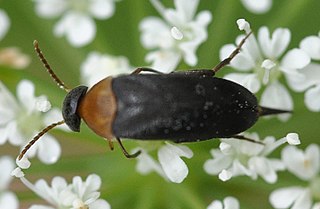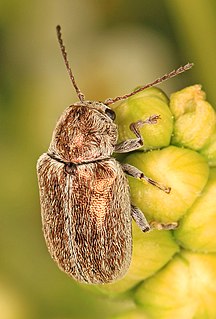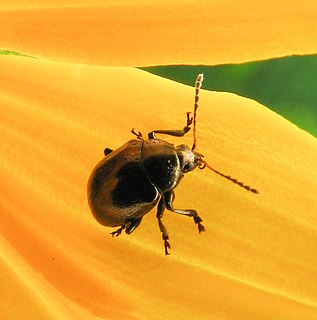
Mordellochroa is a genus of tumbling flower beetles in the family Mordellidae. There are about nine described species in Mordellochroa.
Pseudotolida is a genus of tumbling flower beetles in the family Mordellidae. There are at least 20 described species in Pseudotolida.

Cerylon is a genus of minute bark beetles in the family Cerylonidae. There are about 11 described species in Cerylon.
Glyptoscelis juniperi is a species of leaf beetle. It is found in California in the United States.

Glyptoscelis is a genus of leaf beetles in the subfamily Eumolpinae. There are 38 species of Glyptoscelis described from North, Central and South America. There are also three species of Glyptoscelis known from the West Indies, though they are wrongly placed in the genus. In addition, a single species was described from Hunan, China in 2021.
Graphops comosa, known generally as the Monahans sandhill chrysomelid or long-haired graphops, is a species of leaf beetle. It is found in southeast New Mexico and the adjacent region of Texas.
Glyptoscelis albicans is a species of leaf beetle. It is found in the southeastern United States.
Glyptoscelis alternata is a species of leaf beetle. It is found in the western United States.

Brachypnoea puncticollis, the rose leaf beetle, is a species of leaf beetle. It is found in North America.
Glyptoscelis illustris is a species of leaf beetle. Its range spans from California to Oregon in the United States.
Colaspis planicostata is a species of leaf beetle from North America. It is distributed in southern Texas and in Mexico.
Glyptoscelis prosopis is a species of leaf beetle. Its range spans from southern Texas to Mexico and Central America. It was first described by the American entomologist Charles Frederic August Schaeffer in 1905.
Xenomycetes is a genus of handsome fungus beetles in the family Endomychidae. It is the only genus in the subfamily Xenomycetinae. There are at least two described species in Xenomycetes, both endemic to northwestern North America.
Colaspis pseudofavosa is a species of leaf beetle from North America. It is a post-harvest pest of blueberries in the southeastern United States, and also feeds on plants such as southern wax myrtles and pecans.
Colaspis brownsvillensis, the Brownsville milkvine leaf beetle, is a species of leaf beetle found in the state of Texas in the United States. It was first described by the American entomologist Doris Holmes Blake in 1976 from Brownsville, Texas, after which the species is named. It is a close relative of Colaspis nigrocyanea.
Metachroma viticola is a species of leaf beetle. It is found along the Gulf Coast of the United States, particularly in Texas and Louisiana, and has also been reported from Mexico. Its length is between 4.0 and 5.8 mm. The species name, Latin for "grape vine dwelling", was chosen because the species was reported as injurious to grapes.
Glyptoscelis pubescens, known generally as the hairy leaf beetle or pine chrysomelid, is a species of leaf beetle. It is found in eastern North America. It is a potential pest of pine trees.
Glyptoscelis albida is a species of leaf beetle. It is found in western North America.
Cryptorhynchus fuscatus is a species of hidden snout weevil in the beetle family Curculionidae. It is found in North America.
Glyptoscelis squamulata, the grape bud beetle, is a leaf beetle. The species was first described by George Robert Crotch in 1873. It is found in the western United States.



